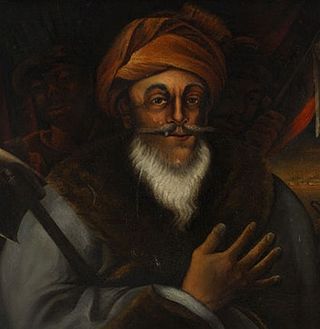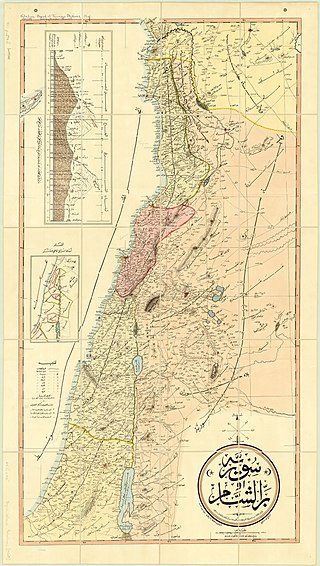
Ibrahim Pasha was an Egyptian general and politician, he was the commander of the Egyptian army and the eldest son of Muhammad Ali, the Wāli and unrecognized Khedive of Egypt and Sudan. He served as a general in the Egyptian army that his father established during his reign, taking his first command of Egyptian forces when he was merely a teenager. In the final year of his life, he succeeded his still-living father as ruler of Egypt and Sudan, owing to the latter's ill health. His rule also extended over the other dominions that his father had brought under Egyptian rule, namely Syria, Hejaz, Morea, Thasos, and Crete. Ibrahim pre-deceased his father, dying 10 November 1848, only four months after acceding to the throne. Upon his father's death the following year, the Egyptian throne passed to Ibrahim's nephew, Abbas.

Ahmed Pasha al-Jazzar born Ahmed Pervan was the Acre-based Ottoman Bosnian governor of Sidon Eyalet from 1776 until his death in 1804 and the simultaneous governor of Damascus Eyalet in 1785–1786, 1790–1795, 1798–1799, and 1803–1804. Having left his native Bosnia as a youth, he began a military career in Egypt in the service of mamluk officials, eventually becoming a chief enforcer and assassin for Ali Bey al-Kabir, Egypt's practical ruler. He gained the epithet of al-Jazzar for his deadly ambush on a group of Bedouin tribesmen in retaliation for the death of his master in a Bedouin raid. Al-Jazzar fell out with Ali Bey in 1768 after refusing to take part in the assassination of one of his former masters. He ultimately fled to Syria, where he was tasked with defending Beirut from a joint assault by the Russian Navy and Zahir al-Umar, the Acre-based ruler of northern Palestine. He eventually surrendered and entered Zahir's service before defecting from him and fleeing with stolen tax money.

Sanur is a Palestinian village located 26 kilometres (16 mi) southwest of Jenin, in the Jenin Governorate of the State of Palestine. According to the Palestinian Central Bureau of Statistics, Sanur had a population of 4,067 in 2007 and 5,036 in 2017. During the late Ottoman era, Sanur served as a fortified village of the Jarrar family and played a key role in limiting the centralized power of the Ottoman sultanate, the Ottoman governors of Damascus and Acre and the Ottoman-aligned Tuqan family of Nablus from exerting direct authority over the rural highlands of Jabal Nablus.

Zeita is a Palestinian town in the Tulkarm Governorate in the western West Bank, located 11 kilometers North-east of Tulkarm. According to the Palestinian Central Bureau of Statistics, Zeita had a population of 3,078 inhabitants in 2017. 21.5% of the population of Zeita were refugees in 1997. The healthcare facilities for Zeita are designated as MOH level 2.
Jarrar is a large Palestinian family that served as rural landlords and tax-collectors (mutasallims) in the Jenin area during Ottoman rule in Palestine. During this era, they were the most powerful of the rural families in Palestine's central highlands.
The Peasants' Revolt was a rebellion against Egyptian conscription and taxation policies in Palestine. While rebel ranks consisted mostly of the local peasantry, urban notables and Bedouin tribes also formed an integral part of the revolt. This was a collective reaction to Egypt's gradual elimination of the unofficial rights and privileges previously enjoyed by the various classes of society in the Levant under Ottoman rule.
The Tuqan clan is a prominent Palestinian and Jordanian political and business family. During the Ottoman era, they dominated the political and socio-economic spheres in Nablus and extended their influence to al-Salt. During that era, they were the only household that came close to establishing centralized rule over Jabal Nablus. Over the course of the 18th and 19th centuries the Tuqan family held the title of mutasallim of Nablus longer than any other local family.

The 1834 siege of Jerusalem took place during the Peasants' revolt in Palestine, which erupted following the entry of Egyptian general Ibrahim Pasha into Ottoman Syria and his subsequent military conscription demand upon the Arab villagers of the region. The siege was engaged by local Arab peasant rebels upon an Egyptian garrison of about 2,000 soldiers, beginning from May 21 until the arrival of Ibrahim Pasha's main force on June 7. The crushing defeat of rebel reinforcements took place on June 9, led by Ibrahim Pasha.
The 1834 Hebron massacre occurred in early August 1834, when the forces of Ibrahim Pasha launched an assault against Hebron to crush the last pocket of significant resistance in Palestine during the Peasants' revolt in Palestine. After heavy street battles, the Egyptian Army defeated the rebels of Hebron, and afterward subjected Hebron's inhabitants to violence following the fall of the city. About 500 civilians and rebels were killed, while the Egyptian Army experienced 260 casualties.
The Ridwan dynasty was the most prominent pasha family in Palestine, ruling the southwestern districts of the Damascus Eyalet in the 16th and 17th centuries under Ottoman rule. The dynasty was based in Gaza, where its members continuously served as the hereditary sanjak-beys of the sanjak for over a century. Members also ruled different provinces and districts throughout the Ottoman Empire and held additional titles at different times. The Ridwan period in Gaza was considered the city's last golden age.
Qasim Pasha al-Ahmad was the chief of the Jamma'in subdistrict of Jabal Nablus during the Ottoman and Egyptian periods in Palestine in the mid-19th century. He also served as the mutassalim of Jerusalem between 1832 and 1833. Qasim headed the Qasim clan, a prominent rural family of Jabal Nablus. He led the peasants of Palestine in their revolt against the Egyptian rule of Ibrahim Pasha in 1834. Following the revolt's suppression, he was captured and executed by the authorities.

Amir al-hajj was the position and title given to the commander of the annual Hajj pilgrim caravan by successive Muslim empires, from the 7th century until the 20th century. Since the Abbasid period, there were two main caravans, one departing from Damascus and the other from Cairo. Each of the two annual caravans was assigned an amir al-hajj whose main duties were securing funds and provisions for the caravan, and protecting it along the desert route to the Muslim holy cities of Mecca and Medina in the Hejaz.
Sulayman Pasha al-Adil was the Ottoman governor of Sidon Eyalet between 1805 and 1819, ruling from his Acre headquarters. He also simultaneously served as governor of Damascus Eyalet between 1810 and 1812. He was a mamluk of his predecessor, Jazzar Pasha. His rule was associated with decentralization, a reduction of Acre's military, and limits to his predecessors' cotton monopoly. Moreover, he oversaw a policy of non-interference with his deputy governors, such as Muhammad Abu-Nabbut and Mustafa Agha Barbar, and diplomacy with the autonomous sheikhs of the various Levantine regions where he held authority, including Emir Bashir Shihab II and Musa Bey Tuqan. He exercised control over his domain largely through depending on the loyalty of his deputies, who also had been mamluks of Jazzar. In effect, Sulayman Pasha presided over the world's last functioning mamluk system.
Abdullah Pasha ibn Ali was the Ottoman governor (wali) of Sidon Eyalet between May 1820 and May 1832, with a nine-month interruption in 1822–23. Like his predecessors Jazzar Pasha and Sulayman Pasha, Abdullah Pasha ruled from the port city of Acre. During his reign, all of Palestine and the Syrian coastline came under his jurisdiction. Among his major military victories was his survival of an imperial-backed siege of Acre in 1822 instigated by the Farhi family in retaliation for Abdullah's execution of his mentor Haim Farhi, the suppression of revolts in Mount Lebanon and Jerusalem in 1824 and 1826, respectively, and the 1831 capture of the Sanur fortress.
Husayn Abd al-Hadi was a sheikh of the Jabal Nablus region, head of the Abd al-Hadi clan of Arraba and a deputy of Ibrahim Pasha in Palestine. During Ibrahim Pasha's rule, he also served as the governor of Sidon Eyalet.
The Naqib al-Ashraf revolt was a popular uprising in Jerusalem against the Ottoman authorities between May 1703 and October 1705. It was led by the city's naqib al-ashraf, Muhammad ibn Mustafa al-Husayni al-Wafa'i, and the rebels consisted of townspeople, peasants from nearby villages, local Bedouins, and religious notables (ulama). For over two years the rebels engaged in virtual self-rule in the city. However, divisions emerged within rebel ranks, and following an Ottoman siege, the rebel camp led by al-Husayni fled the city and were later captured and executed.
Mehmed Pasha Kurd Bayram-zade, also known as Çerkes Mehmed Pasha was an Ottoman statesman. He served as the district governor of Jerusalem, Gaza and Nablus in 1701–1703 and the provincial governor of Damascus in 1702–1703 and 1705–1706.

The Karak revolt was an uprising against Ottoman authority in the Transjordanian town of Al-Karak, which erupted on 4 December 1910. The revolt came after Sami Pasha, the governor of Damascus, wanted to apply the same measures of conscription, taxation, and disarmament to the inhabitants of Al-Karak that previously provoked the Hauran Druze Rebellion.

The Syrian Peasant Revolt was an armed uprising of Levantine peasant classes against the rule of Ibrahim Pasha of Egypt in 1834–35. The revolt took place in areas of Ottoman Syria, at the time, ruled by the semi-independent ruler of Egypt, who conquered the region from loyal Ottoman forces in 1831.
The Turabay dynasty was the preeminent household of the Bedouin Banu Haritha tribe in northern Palestine whose chiefs traditionally served as the multazims and sanjak-beys of Lajjun Sanjak during Ottoman rule in the 16th–17th centuries. The sanjak spanned the towns of Lajjun, Jenin, Haifa and Atlit and the surrounding countryside. The progenitors of the family had served as chiefs of Marj Bani Amir under the Mamluks in the late 15th century.









